|
FAQs about Non-Vertebrate Animal Identification
58
Related Articles: Marine Invertebrates, Marine Invertebrate Systems, Marine Invertebrate Compatibility,
Marine Invertebrate Disease,
Marine Invertebrate
Reproduction, Quarantine of Corals and
Invertebrates, Feeding
Reef Invertebrates, Lighting
Marine Invertebrates,
Water
Flow, How Much is Enough,
Related FAQs: Non-Vert IDs 1, Non-Vert IDs 2, Non-Vert IDs 3, Non-Vert IDs 4, Non-Vert IDs 5, Non-Vert IDs 6, Non-Vert IDs 7, Non-Vert IDs 8, Non-Vert IDs 9, Non-Vert IDs 10, Non-Vert IDs 11, Non-Vert IDs 12, Non-Vert IDs 13, Non-Vert IDs 14, Non-Vert IDs 15, Non-Vert IDs 16, Non-Vert IDs 17, Non-Vert IDs 18, Non-Vert. ID 19, Non-Vert. ID 20, Non-Vert. ID 21, Non-Vert. ID 22, Non-Vert. ID 23, Non-Vert. ID 25, Non-Vert ID 26, Non-Vert ID 27, Non-Vert ID 28, Non-Vert ID 29, Non-Vert ID 30, Non-Vert ID 31, Non-Vert ID 32, Non-Vert 33, Non-Vert ID 34 Non-Vert ID 35, Non-Vert ID 36, Non-Vert ID 37, Non-Vert ID 38, Non-Vert ID 39, Non-Vert ID 40, Non-Vert ID 41, Non-Vert ID 42, Non-Vert ID 43, Non-Vert ID 44, Non-Vert ID 45, Non-Vert ID 46, Non-Vert ID 47, Non-Vert ID 48, Non-Vert ID 49, Non-Vert ID 50, Non-Vert ID 51, Non-Vert ID 52, Non-Vert ID 53, Non-Vert ID 54, Non-Vert ID 55,
Non-Vert ID 56, Non-Vert ID
57, Non-Vert ID 59,
Non-Vert ID 60, Non-Vert ID 61,
& Marine Invertebrates,
Marine Invert.s 2,
Marine Invert.s 3, & FAQs about:
Marine Invertebrate Behavior,
Marine Invertebrate
Compatibility, Marine
Invertebrate Selection, Marine
Invertebrate Systems, Feeding
Reef Invertebrates, Marine
Invertebrate Disease, Marine
Invertebrate Reproduction, &
& LR
Life Identification, LR Hitchhiker ID
1, Anemone Identification,
Aiptasia
Identification, Aiptasia ID 2,
Worm Identification, Tubeworm ID, Polychaete Identification, Snail Identification, Marine Crab
Identification, Marine Invert.s 1,
Marine Invert.s 2, Marine Plankton,
|

|
|
Professional ID ' er needed!
6/4/12
Hello everyone!
Can someone please id these polyps?
I haven't the slightest idea, as they don't 'open' or anything, but do
seem to be multiplying!
This is their true colors too. Pretty ugly huh?
They don't pop and they are soft and slimy :)
Thank you!
Pam
3 pictures for you
<Mmm, do I see two openings on each? Of dissimilar size? These are
likely Tunicates/Ascidians... not harmful filter-feeders... indicative
of livable conditions in this system. Bob Fenner>
|

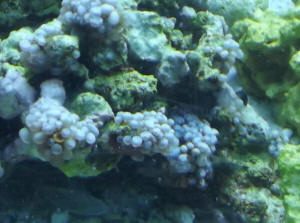 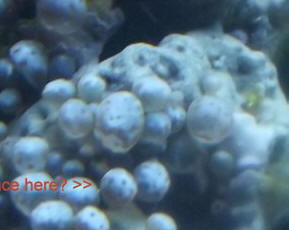 |
Re: Professional ID ' er needed! Ahhh, Bob F.
please?
6/4/12
Tunicates? Well, it's nice to have something for this $68 piece of rock!
When I first bought it 4 months ago, everything died off (or so I thought!)
while the tank cycled.
Puzzling thing is that when I bought the rock, these animals were green.
Do you still think they're Ascidians?
<My best guess; yes. Need a better-resolved image to be surer. B>
Here are a couple more pictures I zoomed in on .
I got to say Bob, they look very happy! :
|
more id's please? 6/15/12
Can someone identify this "growth" in picture one and two?
<Ah yes... these are sponges Pam. An indication of steady, good
conditions>
I've looked through WetWebMedia and other sites, and my guess is some
sort of leather coral? It's getting bigger every day.
And the last picture, Bob fenner gave an educated guess of Tunicates.
since then, I've researched these little squirts, and I just don't see
the inhalant and the exhalant siphon holes. They are more 'mottled' than
anything else.
Thanks so much!!
Pam
<The third, circular, colonial bits are Sea Squirts still in my
guestimation. Also harmless. Bob Fenner>
|
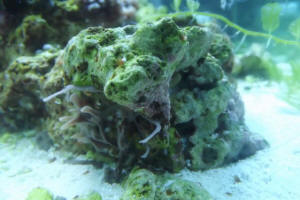
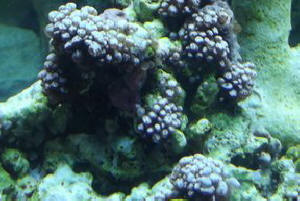 |
|
|
Unidentified Egg Casings? (and the unknown worm) – 5/26/12
Hello, I hope you are doing well.
<Thanks Rhi, and back at you. How may I help you today?>
I got up this morning to find 9 transparent "things" sticking out of the
sand bed and I hope you can assist in their identification.
<I’ll certainly try.>
They appear to be shell casings
<Definitely egg capsules/casings of some sort.>
…from something, my question is, what?
<That’s a good question. What snail species do you currently have in
stock?>
They are approximately an inch to an inch and a quarter in height
<That’s a sizeable capsule.>
…and appear to have a base made of sand. A photo of dubious quality is
included.
<It looks good to me, thanks.>
I have a good deal of diversity in my reef tank, including many species
of snails and some odd creatures I sent pictures of before. Sadly we
weren't able to identify those
<Yep, I remember those and despite further research, I still don’t know
what they are. Unsolved ID’s like that really prey on my mind
until solved.>
..and upon advice I tried to remove one that was irritating a Duncan
colony with tweezers and all the "fluffy parts" at its base flew off and
are now populating multiple areas of rock around the tank and irritating
various other corals at night.
<Oh no, I’m so sorry! That’s the downside of not knowing what sort
of creature we’re dealing with.>
Since those appear to reproduce via some kind of cloning at the base I
don't suppose the eggs belong to the unidentified worm-thing.
<Nope, I would seriously doubt it.>
However, I will include a photo of it with its "babies" that I took once
the worm was removed, just for curiosity's sake. I really would love to
know what they are.
<You and me both! I’m going to do some more research, ask some
people and see what I can find. It may take awhile, but if/when I get an
answer, I’ll be sure to let you know.>
Thanks for your time,
<You’re very welcome. Do let me know what snail species you
currently have and we’ll figure out which one left those capsules.>
Rhi
<Take care, Lynn Z>
|
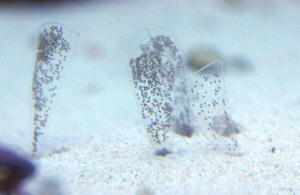
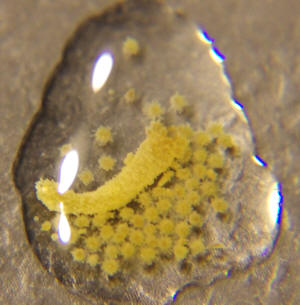 |
|
Re: Unidentified Egg Casings? (and the
unknown worm): Possible Babylonia Egg Capsules - 5/27/12
<Hello Rhi>
As you know, vendors of aquatic life are not the most accurate when it
comes to labeling their "merchandise"
<Yes, unfortunately it’s not a priority for some. It puts the onus
on the consumer to beware and research before bringing any organism(s)
home.>
… and I acquired my CUC from various places, but I will do my best to
identify what I have in the tank now.
<Thanks, I appreciate it.>
Astrea snails (Astraea tecta)
<This has been reclassified as Lithopoma tectum but the old species
name, Astraea tecta, is still widely used. This is a broadcast
spawner (eggs and sperm released into the water column), so it’s out of
the running as far as producing egg capsules.>
Large Cerith snails (Cerithium sp.)
<Reproduction can vary with these but we can rule them out as well. Most
that we see in the hobby leave either clear to translucent meandering
ribbons dotted with eggs, or whitish, rope-like “snail trails” adhered
to hard surfaces or sometimes anchored to, and strung across, seagrasses
or macroalgae.>
Margarita snails (Margarites pupillus)
<These are broadcast spawners, so no capsules. They’re also a
cooler-water species that doesn’t last long when exposed to the higher
temperatures of reef systems.>
…tiny Nassarius snails (Nassarius sp.) - based on shell coloration there
appears to be multiple types here
<Nope, no capsules here either. They tend to deposit eggs in
swaths and “trails” on hard surfaces.>
36 Caribbean Nerite snails (Nerita sp.)
<Nerites do produce capsules deposited in loose groupings, but they're
typically low profile, white to cream-colored, and round to oval in
shape.>
Stomatella varia
<These are broadcast spawners, so no capsules.>
2 huge "Orange spot Nassarius snails" (Babylonia formosae?) which now
after looking up their scientific name am concerned are actually
carnivorous whelks that killed rather than "cleaned up" my baby maxima
clam that died recently. (The tank was laying fallow and so was being
fed lightly due to dearth of fish)
<Yikes, yep Babylonia snails and bivalves are not a good combo – at
least as far as the bivalves are concerned! This species does
however leave egg capsules that are typically adhered to a hard
substrate. Unfortunately I can’t find any photos for comparison.>
a couple of Turbo snails (Turbo fluctuosa)
<Turbo’s typically either broadcast spawn or release an egg mass,
sometimes adhered to a surface, sometimes loose.>
The eggs are still present and unchanged in the tank and I look forward
to hearing from you.
<Well, by process of elimination, the most likely candidate is the
Babylonia snail. It also makes sense because of the size (big
snail - big capsules) but I’d feel a whole lot more confident if I could
find a photo for confirmation. If they are indeed from this snail,
the young should begin to emerge after about 5 days and enter into a
planktonic larval (”veliger”) stage that lasts around 8 - 10 days.
Unfortunately, the fact that they do go through a free-swimming phase
limits their chance of survival as they are exposed to all manner of
threat, from livestock as well as equipment.>
Thanks again for your time.
<You’re very welcome. Again, I’ll let you know if/when I’m able to give
you an answer regarding the other worm-like critters.>
Rhi
<Take care, Lynn Z>
|
|
ID Help Please: Poriferan – 5/22/12
Hey gang,
<Hey there, Lynn here this morning.>
Any chance of helping me ID this please?? Is it a sponge or hard coral
at least?!
<It’s a sponge/Poriferan. Please see the following link for more
information:
http://www.wetwebmedia.com/sponges.htm >
Many thanks!
<You’re welcome! Take care, Lynn Z>
|
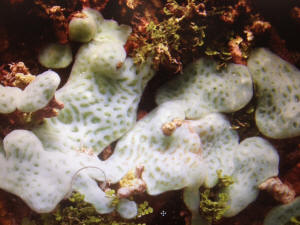
Re: ID Help Please: Poriferan – 5/22/12
Thanks ever so much! :-)
<You’re very welcome!>
Would you know, from the picture, which family/genus it belongs to?
<Not with any certainty, no. Offhand it resembles a species of
Clathrina (family Clathrinidae) but there are an awful lot of sponges out
there and they can vary to surprising degree. The best means of
identification is actually through examination of the skeletal
parts/spicules under a microscope. Please see the following link for
an example of a Clathrina species:
http://www.poppe-images.com/?t=17&photoid=935835 >
Thanks again!
<You’re most welcome! Take care, Lynn Z>
|
|
white vines
5/4/12
Hi there,
Huge fan of the site! I have never had to ask a question before have
always been able to find what I was needing to know on your site. It is one
very informative place here. Well this I couldn't find anywhere, I have been
searching not only the web but your site for past 2 evenings and still
nothing. I have something that looks like a vine, it is white and there are
hundreds of these things coming from under one of my rocks on just one side
of my tank. They have now crept over to a beautiful (what was) torch coral I
have and climbed up the stalk of the torch and slowly taken it out. These
things look just like a vine and are pure white, slowly spreading. I cant
find a pic or any info on this whatsoever. really hope you can help me out
here. I have attached 2 pictures and in these pictures what Im speaking of
is in the background straight behind the torch. I have tried trimming a lot
of this off so I hope you can see what Im talking about. Thanks in advance
Corey
<Can't quite make out these "vines" in your small pix... If they're
retractile, my guess might be that this is some sort of "Spaghetti Worm" (do
search w/ these words)... IF the growth is indeed mal-affecting the
Euphyllia, maybe this is some sort of sponge, Hydrozoan... Please send along
a larger, better resolved pic if you can. Bob Fenner>
|
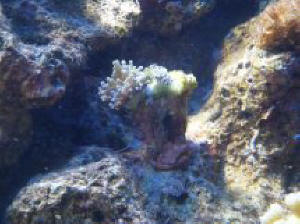 |
|
assistance with worm identification
- 4/18/12
Hello,
<Hi Rhi>
Firstly, thank you for the wealth of information and aquatic knowledge that
is WWM. You have helped me so much in the past, however, I must ask
for some personal attention this time as I have been completely unable to
find my answer despite much searching.
<Have been thinking re this all last night...>
There are 2 particular worms amongst many others in my mixed reef tank that
I have been unable to identify. At night they extend to approx 3-4" but
retract quickly in response to any light, including camera flashes, so my
photos are of them retracted to about 1/2", as they are in the day. Could
you please help identify them, and advise whether they are a threat to me,
my fish or corals?
Thank you so much,
Rhi
<Don't know what this is... might be a worm, but... and I wouldn't remove
it/them... Please do send along a better-resolved head/cephalic region image
if you can. Bob Fenner>
|
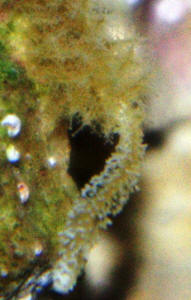
|
Re: assistance with worm identification
4/20/12
Sorry about the delay getting back to you. I have made several attempts to
get better pictures of these creatures with a number of cameras, including
an underwater model. I took a great many pictures and included the better of
them, sadly I don't think they are any more help than the last one I sent.
They are very small and attached to a piece of rock that is at the
base of a large arch so unable to be moved for photographing. I did take a
short video of them and posted to YouTube in the hopes that it be of some
assistance. http://youtu.be/iEPZ9HyuE70
One of these things is able to reach several heads of a Duncan coral when
fully extended and appears to be at the least irritating them, causing some
withdrawal, which is concerning to me. Also of note is that they are
somewhat mobile as these 2 have been present in my tank for a lot longer
than the piece of rock upon which they currently reside, but they have not
moved from their current location for at least a month.
Thanks again for your time,
Rhi
<Still quizzical to me... these better pix show what look to be small
"sucker" over the body of the animal... and it doesn't appear to be
segmented, is capable of rapid retraction... Am going to send your mail/pix
over to Lynn Zurik, our resident marine invertebrate ID expert... and hope
she can state more. My guess is currently that this is some sort of Sea Pen,
Pennatulacean... Bob Fenner>
|
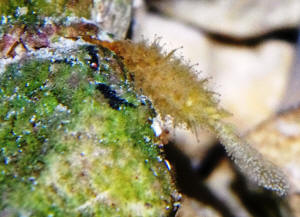
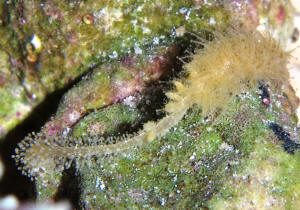 |
|
Re: assistance with worm identification
4/20/12
Thanks Bob, this thing has been bugging me since the first time I saw
it!
Offhand it doesn't strike me as a Polychaete but there are an awful lot
of odd ones out there so who knows? Thankfully I've got some time
today, and some other possibilities tumbling about in my mind, so I'll
see what I can find.
Take care,
-Lynn
<Thank you Lynn... does not appear segmented... and the rapid movement?
B>
Re: assistance with worm identification – 4/20/12
<<Hi Rhi, Lynn here today trying to figure out what sort of critter you
have!>>
Sorry about the delay getting back to you. I have made several attempts
to get better pictures of these creatures with a number of cameras,
including an underwater model. I took a great many pictures and included
the better of them, sadly I don't think they are any more help than the
last one I sent.
<<Actually, they’re very good. I was able to see a lot more
detail, but unfortunately, I don’t have a concrete ID for you.>>
They are very small and attached to a piece of rock that is at the base
of a large arch so unable to be moved for photographing. I did take a
short video of them and posted to YouTube in the hopes that it be of
some assistance. http://youtu.be/iEPZ9HyuE70
<<It’s great, thanks!>>
One of these things is able to reach several heads of a Duncan coral
when fully extended and appears to be at the least irritating them,
causing some withdrawal, which is concerning to me.
<<That’s understandable. I would opt for manual removal of this
individual. Just take a pair of tweezers (or similar), grasp where
it’s attached to the rock and detach).>>
Also of note is that they are somewhat mobile as these 2 have been
present in my tank for a lot longer than the piece of rock upon which
they currently reside, but they have not moved from their current
location for at least a month. Thanks again for your time, Rhi
<Still quizzical to me... these better pix show what look to be small
"sucker" over the body of the animal
<<Yep, they look like the tube feet you see on Echinoderms, and the main
“body” looks like it could be a Cuke/Holothuroid of some sort, but the
feeding apparatus is all kinds of wrong for a Cuke that appears to be a
suspension or filter-feeder.>>
... and it doesn't appear to be segmented. Am going to send your
mail/pix over to Lynn Zurik, our resident marine invertebrate ID
expert... and hope she can state more.
<<I sure wish I could, but I’m not sure what that thing is. I
haven’t given up though, so if I do figure it out, I’ll let y’all
know.>>
My guess is currently that this is some sort of Sea Pen,
Pennatulacean... Bob Fenner>
<<Yep, that’s the closest I can get at the moment as well – maybe
something in the genus Veretillum with closed polyps?? Sorry I couldn’t
be of more assistance! Take care, Lynn Z>>
|
|
|
Is this a friend or foe in my aquarium?
2/9/12
Hi
<Bob>
I stumbled upon your website a few days ago while trying to
identify some things that are going on in my wife Teal's
aquarium. I bought this established aquarium a few months ago and
it is our first large aquarium.
She has also maintained an 8 gallon biocube for about a year with
good luck.
<A feat!>
This tank was purchased with lots of Liverock. Critters that came
with it were a tomato clown, a Naso tang,
<I hope this tank is large... at least a six foot length. See
WWM re Naso lituratus care>
and a percula clownfish. We also got a few anemones in the tank
as well as some large snails and feather duster worms. When we
were tearing the tank down before moving it, the guy mentioned
that they found worms in the tanks, possible bristle worms.
<No big deal generally>
Today my wife said that she removed a few of the worms from the
tank. When we set up the tank in our house we put in 80 lbs of
aragonite sand.
There are a couple spots like what is shown in the picture in the
tank and it is a concern of hers. There appear to be a few snail
like creatures living in this stalagmite looking tube.
<Indeed they are. Please see here:
http://www.wetwebmedia.com/MolluscPIX/Gastropods/Prosobranch%20PIX/Vermetids/tubesnailidf.htm>
At times we see a web like material
stringing from them and it appears that they are catching or
snagging floating debris and them reeling it back in for them to
feed on.
<Well put>
Can you identify what is in this picture and can/should I leave
them alone?
<Are tube snails of some sort and I would keep them>
Are they harmful to her tank? If I need to remove them, what is
the best way?
<Not harmful. IF you wanted to remove, best to use a pliers or
such, and break off the base of whatever they're attached
to>
I love your site (from what I've seen) and will be back to do
more identification on things in her tank.
Thanks very much!
Bob and Teal
<Welcome. Bob Fenner>
|
 |
Need help with an ID 1/4/12
Hello and thank you for the site. It has been super informative.
<Welcome>
I have recently bought a colony of Clove polyps and have found a couple of
"free" specimens on the rock. I have searched your site at length, using Eric's
tips, and cannot find this coral(?).
<Mmm, please send along a well resolved photo>
It consists of tubes stacked vertically around each other, in groups of
three, five, and seven tubes. They are gray in color and are connected on the
substrate, like the Cloves are. They are also reactive to touch and pull in a
bit, they do not retract fully like Cloves do. The center tube is
higher than the others by one or two mm. I have a picture but could not compress
it below 900 kb, am trying to follow your guidelines as stated.
<Do send this along. This size is fine>
I can send if file size ok. They are semi-soft to the touch and flexible, cannot
see sclerites or skeleton as color is opaque. The tubes terminate at top with
feathery tips but no "flowers". Thank you for any help you can offer.
<Does "sound" (read) like a Hydropolyp... Bob Fenner>
|
|

